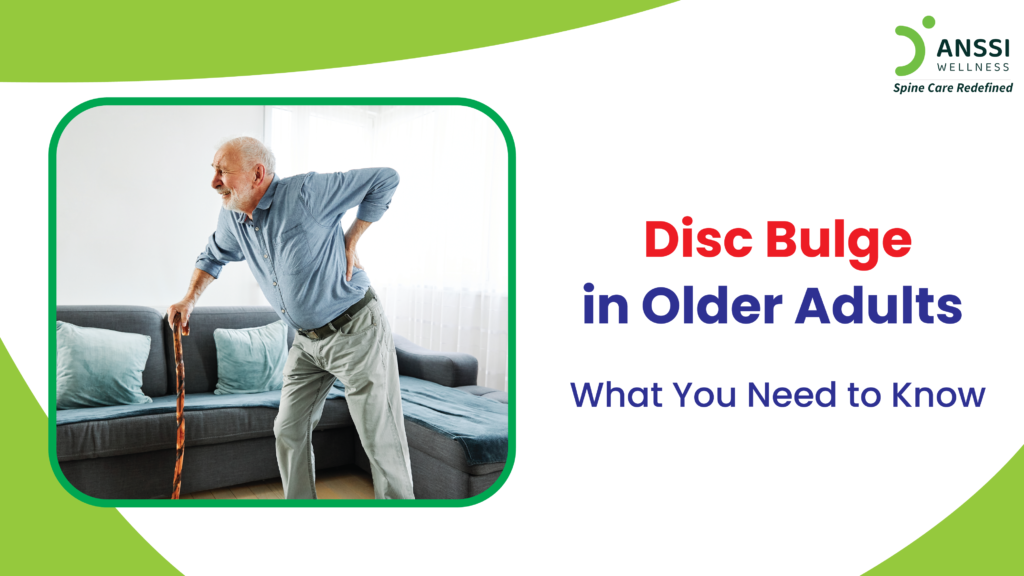As you age, your body goes through natural changes, and the spine is no exception. In your golden years, one common issue that you may face or probably are facing now is a disc bulge, which can cause pain, stiffness, and mobility issues.
This condition occurs when the spinal discs, the soft cushions located between the vertebrae, start to weaken and lose their flexibility, leading to bulging or protruding. While it can be uncomfortable, effective treatments are available to manage symptoms and improve the quality of your life.
So, let’s explore the causes, symptoms, and treatment options available for disc bulges in seniors, with a focus on non-surgical spinal decompression as a safe and effective solution.
What Causes Disc Bulges in Older Adults?
As you get older, your spinal discs go through natural degenerative changes, which increase the likelihood of disc bulging.
Several factors contribute to this condition:
- Degenerative Disc Disease (DDD): Over time, the discs lose water and elasticity, making them more prone to bulging.
- Loss of Disc Height: With ageing, the discs shrink, reducing the space between vertebrae and increasing pressure on spinal structures.
- Osteoarthritis and Bone Spurs: The formation of bone spurs can lead to the narrowing of the spinal canal, which puts stress on the discs.
- Poor Posture: Years of improper posture can lead to misalignment and increased strain on the spine.
- Inactivity and Weak Muscles: Weak core and back muscles provide less support to the spine, making disc bulges more likely.
- Previous Injuries: Older adults who have experienced back injuries in the past may have a higher risk of disc degeneration.
Common Symptoms of Disc Bulge in Seniors
The severity of symptoms depends on the location and extent of the bulging disc. Some older adults may not feel any discomfort, while others experience significant pain.
Common symptoms include:
- Chronic Back or Neck Pain: Depending on the affected area, pain may radiate to the arms, legs, or buttocks.
- Stiffness and Reduced Flexibility: Many seniors experience difficulty bending, twisting, or getting out of bed.
- Numbness or Tingling: A bulging disc may press on nearby nerves, causing sensations in the hands, feet, or legs.
- Weakness in Limbs: Nerve compression can result in muscle weakness, making activities like walking or gripping objects difficult.
- Difficulty Standing or Sitting for Long Periods: Prolonged sitting or standing may aggravate pain due to pressure on the discs.
If left untreated, a bulging disc may worsen over time and lead to herniation, increasing pain and nerve damage.
How is Disc Bulge Diagnosed?
To diagnose a bulging disc, a spine specialist typically performs the following:
- Physical Examination: Doctors assess posture, flexibility, and reflexes to identify signs of nerve compression.
- Imaging Tests: MRI and CT scans provide detailed views of the spinal discs and surrounding structures.
- Nerve Function Tests: In cases where nerve involvement is suspected, electromyography (EMG) may be used.
Early diagnosis allows for better treatment planning and prevents further deterioration.
Treatment Options for Older Adults with Disc Bulges
The goal of treatment is to reduce pain, restore mobility, and prevent further complications. Older adults often benefit from non-surgical treatments, as they are safer and more suitable for age-related spine conditions.
Non-Surgical Treatments
- Spinal Decompression Treatment: One of the most effective non-surgical treatments for bulging discs, spinal decompression gently stretches the spine, creating space between the vertebrae. This reduces pressure on the disc and promotes healing. Unlike surgery, it is 100% non-invasive and safe for seniors.
- Physical Therapy: Guided exercises help strengthen back muscles, improve posture, and reduce pain.
- Posture Correction: Using ergonomic chairs, lumbar support cushions, and proper sleeping positions can relieve stress on the spine.
- Medications: Doctors may prescribe anti-inflammatory drugs or muscle relaxants for temporary relief. However, long-term use of painkillers should be avoided.
- Heat and Cold Therapy: Applying heat can relax muscles, while ice packs help reduce inflammation.
- Lifestyle Adjustments: Staying active, maintaining a healthy weight, and avoiding prolonged sitting can significantly improve spinal health.
Surgical Treatment (For Severe Cases Only)
Surgery is rarely needed but may be recommended if:
- Non-surgical treatments fail to provide relief.
- There is significant nerve compression causing loss of bowel/bladder control.
- The patient experiences severe weakness in the legs.
Common surgical options include laminectomy (removal of bone spurs) and discectomy (removal of part of the disc). However, surgery comes with risks and should only be considered when absolutely necessary.
Why Spinal Decompression is the Best Choice for Seniors
Non-surgical spinal decompression treatment is a safe and effective treatment for seniors suffering from disc bulges.
Here’s why:
- Non-Invasive and Painless: Unlike surgery, it does not involve incisions, injections, or medication.
- Encourages Natural Healing: It promotes nutrient-rich blood flow to the damaged disc, helping it recover.
- No Downtime Required: Patients can resume their daily activities without long recovery periods.
- Effective Pain Relief: Many seniors experience significant improvement within a few sessions.
This treatment offers a gentle, drug-free alternative to managing chronic spine conditions in older adults.
Preventing Disc Bulges: Tips for Seniors
While ageing cannot be stopped, you can protect your spine and reduce the risk of disc bulges by:
- Maintaining Good Posture: Keep your back straight while sitting and avoid slouching.
- Engaging in Low-Impact Exercises: Walking, swimming, and stretching help strengthen back muscles.
- Using Proper Lifting Techniques: Avoid bending at the waist; instead, bend your knees when picking up objects.
- Eating a Balanced Diet: Calcium and Vitamin D support bone and spine health.
- Staying Hydrated: Water keeps your spinal discs hydrated and flexible.
By following these tips, older adults can enjoy pain-free, active lifestyles.
About ANSSI:
ANSSI Wellness focuses on improving the quality of life for patients suffering from spinal issues, aiming to provide relief where other conventional treatments have failed. Through advanced non-surgical spinal decompression treatment, ANSSI is committed to helping patients avoid surgery and recover in a safe, effective, and compassionate environment.
Connect with ANSSI Wellness on LinkedIn, Instagram, and Facebook for expert guidance.



